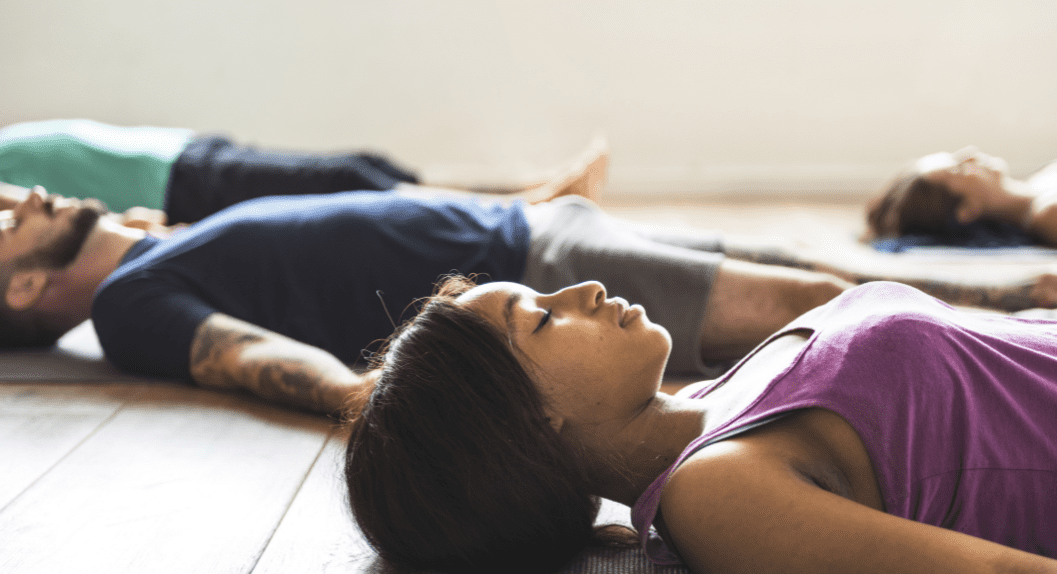What distinguishes Integral Yoga Hatha from many other schools of instruction is its meditative approach. During a class we systematically still the body, calm the breath, and then quiet the mind, so that, ultimately, we can transcend the body and mind and experience the True Self. To enhance the meditative experience, various techniques can be presented and practiced during a class, at the end of class during the meditation portion, or in course classes. A specific technique, or a group of techniques can be developed in each session. The following are various suggestions on how to incorporate meditation techniques into your classes.
FOCUSING ON THE BREATH
- Focus on the breath and the subtle energy currents.
- During class, use the breath to help release tension and go deeper into the poses.
- At the end of the class, you may introduce various meditations on the breath. You can ask the students to observe the movement of the abdomen, or concentrate on the flow of air at the nostrils, or notice the energy along the spine. You could also have a Soham meditation on the sound of the breath.
VISUALIZATION TECHNIQUES
- Do an asana. Then, visualize it done perfectly, and re-execute it. Observe the power of a focused mind over the body.
- Do pranic healing visualizations during deep relaxation. Go through the normal routine. After the students have rested in the peace for a couple of minutes, have them visualize themselves surrounded by an infinite field of energy. This can be in the form of any natural energy that appeals to them, such as water, fire, wind, or light. They can visualize the energy flowing in a continual stream, entering through the top of the head, travelling down the body, and then exiting through the soles of the feet. If there is a problem in a certain area, the energy can go there on its path through the body. Direct the energy to do whatever healing or rejuvenation is needed, and then direct all the toxins and problems to leave through the soles of the feet.
- Do pranic healing visualization during pranayama. Try this with deep or alternate nostril breathing. When you inhale, visualize drawing unlimited quantities of healing prana into yourself along with the breath. If there is a problem in a particular area of the body, you can mentally direct the prana to go there. During retention, feel like the prana is being super-injected into the system. During exhalation, feel that the toxins are leaving with the breath.
RAJA YOGA TECHNIQUES
Raja Yoga is the path of concentration and meditation. Based on ethical perfection, it offers a systematic approach for gaining control over the mind. It is suitable for people who like to apply their will power in dealing with life’s situations and who wish to learn about all aspects of their minds. A Raja Yogi seeks to gather and direct all his mental energy to the task at hand, so he can understand and accomplish it most successfully.
Hints for Hatha Yoga Practice:
- Keep your mind focused on what you are doing. Do not daydream, dwell on the past, or plan for the future. Fulfill the action of the moment with all your concentration.
- Repeat a holy mantra as you do the asanas. That way, part of the mind will be absorbed in the divine vibration of the mantra. Of course, if you need your full attention to work with the body, you can leave the mantra for a while, and then return to it when you feel ready to do so.
- Observe the asanas you enjoy doing and those you dislike; those you usually do well and those where you feel tense or stuck. Analyze and find out your strengths and weaknesses. Observe where and when your peace gets disturbed.
- Discuss one of the precepts of yama or niyama at the beginning of class. Then have the students reflect on it as they perform the asanas and have them observe how this influences their practice.
BHAKTI YOGA TECHNIQUES
Bhakti Yoga is the path of devotion. It is suitable for people who have an emotional nature. Bhakti Yogis act with the feeling that they are doing everything as an offering to the Lord. They look upon everyone and everything as a manifestation of their beloved Lord, and feel that in serving them, they are serving God. They surrender the fruits of their actions to the Lord and accept all that happens in life as coming directly from God for their highest good.
Hints for Hatha Yoga Practice:
- At beginning of class offer a prayer for the health and well being, healing and rejuvenation of the body. During the class, maintain a prayerful attitude. At the end of class, offer a prayer of thanksgiving for the knowledge, guidance, and grace to do the poses.
- After every asana, take a moment to mentally offer it to the Divine.
- Feel that your body is a temple of the Divine, and perform the asanas as worship of the Divine.
- Try to feel God’s Peace and Presence within you.
- Feel that God is present, watching you. You can mentally converse with God as you do the asanas.
JNANA YOGA TECHNIQUES
Jnana Yoga is the path of wisdom. It is suitable for people of an intellectual nature. A Jnana Yogi acts with the feeling, “I am not the doer; Nature is doing everything. The body and mind are moving among the objects. I am the silent witness of all that is happening. The work does not bind me; I am free.” All of creation is seen as the play of Maya, or illusion. The Jnana Yogi constantly discriminates between the unreal and the Real, the not-Self and the Self. This path requires a sharp and subtle intellect.
Hints for Hatha Yoga Practice:
- Cultivate the attitude of the witness as you do the asanas. Strive to identify with that part of the mind that is aware of all that is happening, rather than the part that is engaged in the action.
- Observe the contents and attitude of your mind as you go through the poses.
- If the mind gets disturbed, question it, “Who is getting disturbed?” Realize that nothing can ever disturb the True You.
- Try the following sequence in doing the asanas:
- observe the mind;
- get into pose;
- hold the pose for a few moments;
- observe the body and mind;
- release any tension and adjust the pose. See if you can perform the asana more effectively, and with greater steadiness and ease, by following this procedure.
KARMA YOGA TECHNIQUES
Karma Yoga is the path of action. It is suitable for people of an active temperament. The Karma Yogi leads a dedicated life as an instrument of God. All actions are done as selfless service with no expectation of personal reward. The Karma Yogi makes no appointments, and thus has no disappointments. Such a life purifies the heart and makes it fit to realize the Supreme Truth.
Hints for Hatha Yoga Practice:
- Do your best and leave the rest. Apply yourself as best you can, and don’t get excited or anxious over the results.
- Concentrate on each movement; on every action made by the body. Perform them as carefully, gently, and efficiently as possible.
- As you do the poses, feel that you are an instrument in God’s hands, carrying out the Higher Will.
- Maintain the attitude that you are doing the asanas to purify and strengthen your body so that you can better serve others.
By incorporating a meditative approach in your classes, you will help your students to go deeper in their practice. Try different techniques because students will vary in their temperament and capacity. Experiment with these and other meditation techniques in your own practice, and then bring your own experience and insights to bear when you present them to your students. Have fun and enjoy the journey. As someone once said, “It’s good to have an end to journey toward, but it is the journey that matters in the end.” May yours be one of wonder, discovery, and ever-deepening joy.



